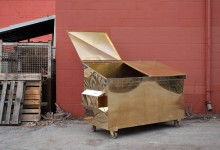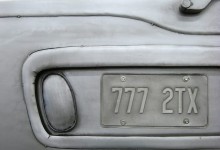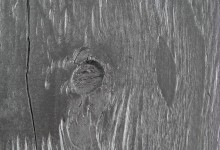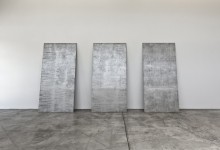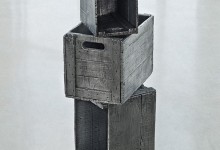Opening reception: Saturday, March 5th from 3-5pm
Zeke Moores: Wasted
Text by Terence Sharpe
Attacking the medium of sculpture from a position of almost anti-fine art clarity, Zeke Moores alters conceptions of how we relate to material and form. There is an appreciation of medium in his work that bears the transparency of a skill set routed in fabrication and foundry that questions the social significance of his objects. There is very deliberate re-imagining that takes place when one encounters these objects. The function and form of each work alters its original stake in our economy. Each work takes on a different cultural significance in an attempt to harness the means of production and question our relation to everyday materials.
Observing works like Construction Grade (2008) and Sign (2013) draws attention to the carving of grain textures resembling woodwork. These cast aluminium structures command the space they inhabit, imposing their dead weight on the viewer in a visceral manner. Their strength and almost ominous disposition become displaced upon closer inspection. It is a form of sensory disorientation to observe patterns resembling wood engraved into these steel slabs, one expects the smell of sawdust but is met with the cold vision of metal. There is a sense of nervousness that comes with this realization, expectations are thrown and a peculiar attempt at recognition leads to a reassessment of what materiality is.
Often a sense of home comes with the symbol of a blanket. But in the hands of Moores this object must be approached with trepidation. Once again cast aluminium undermines the viewers’ sense of structure, weight and density and the senses are obfuscated in a manner that creates unease. Blanket (2013) offers the viewer and object of luxury but mechanizes it as threatening, its soft contours assume menace to the point of confrontation. Our items of grandeur in our homes have been circumvented, we question how our possessions are made, by what and who by – we realize we are consumers of artisanal violence with no sense of wrongdoing and succumb to our positions as nodes in networks of international force-fed styles and the serial homogenization of fractal-based reproduction units.
Dumpster (2010) creates an abject structure of glory that reflects its surroundings with a sheen of glamour further aestheticizing disorientation. As one gazes into the shimmering abstract reflections on this sculpture, there is a distinct visual coda to the reflexive, uncanny miasma that emanates from the other works. In a hyper-real spectacle of bling, the dumpster, a home for waste, signifies the waste of those who contribute to its insides. Its original function has been subdued. It can no longer serve its purpose. Under interrogation, the works have renounced their autonomy, much like their consumers. The works in this exhibition allude to our complicit behaviour in the means of production. Once the disruption of the senses subsides, the cold realization that we yearn for a critical separation is dulled by the banal psychopathologies that lead us back into circulation.


